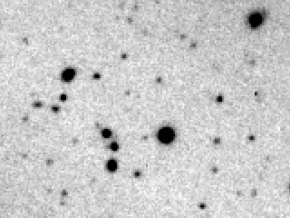(432949) 2012 HH2
 Astronomical Research Institute discovery animation of 2012 HH2 | |
| Discovery | |
|---|---|
| Discovered by | T. Vorobjov (H20)[1] |
| Discovery date | 19 April 2012 |
| Designations | |
| 2012 HH2 | |
| TNO centaur (DES)[2] | |
| Orbital characteristics[1][3] | |
| Epoch 4 September 2017 (JD 2458000.5) | |
| Uncertainty parameter 2 | |
| Observation arc | 13.93 yr (5,087 days) |
| Aphelion | 41.015 AU |
| Perihelion | 29.221 AU |
| 35.118 AU | |
| Eccentricity | 0.1679 |
| 208.11 yr (76,013 days) | |
| 32.421° | |
| 0° 0m 16.92s / day | |
| Inclination | 28.534° |
| 56.518° | |
| 101.69° | |
| Physical characteristics | |
| Dimensions | 170–300 km |
| 6.3[1] | |
(432949) 2012 HH2 is a trans-Neptunian object (TNO) and weak dwarf planet candidate.[4] It was discovered by Slovak astronomer Tomáš Vorobjov from images taken on the night of 19 April 2012, at the Astronomical Research Institute in Illinois, United States. The object has been observed forty-two times[1][3] over two oppositions.[1] It is currently 29.8 AU from the Sun.
References
- ^ a b c d e "JPL Small-Body Database Browser: (2012 HH2)" (2012-06-10 last obs). Retrieved 8 April 2016.
- ^ Marc W. Buie (2013-02-09). "Orbit Fit and Astrometric record for 12HH2". SwRI (Space Science Department). Archived from the original on 2014-09-07. Retrieved 2013-02-08.
- ^ a b "2012 HH2". IAU Minor Planet Center. Archived from the original on 2016-03-03. Retrieved 2012-06-14.
{{cite web}}: Unknown parameter|dead-url=ignored (|url-status=suggested) (help) - ^ Michael E. Brown. "How many dwarf planets are there in the outer solar system? (updates daily)". California Institute of Technology. Retrieved 31 August 2016.
External links
- MPEC 2012-H36 : DAILY ORBIT UPDATE (2012 APR. 21 UT) (Discovery mention on Daily Orbit Update)
- MPEC 2012-L20 : 2012 HH2 (Revision to MPEC 2012-J31)
- (432949) 2012 HH2 at the JPL Small-Body Database


